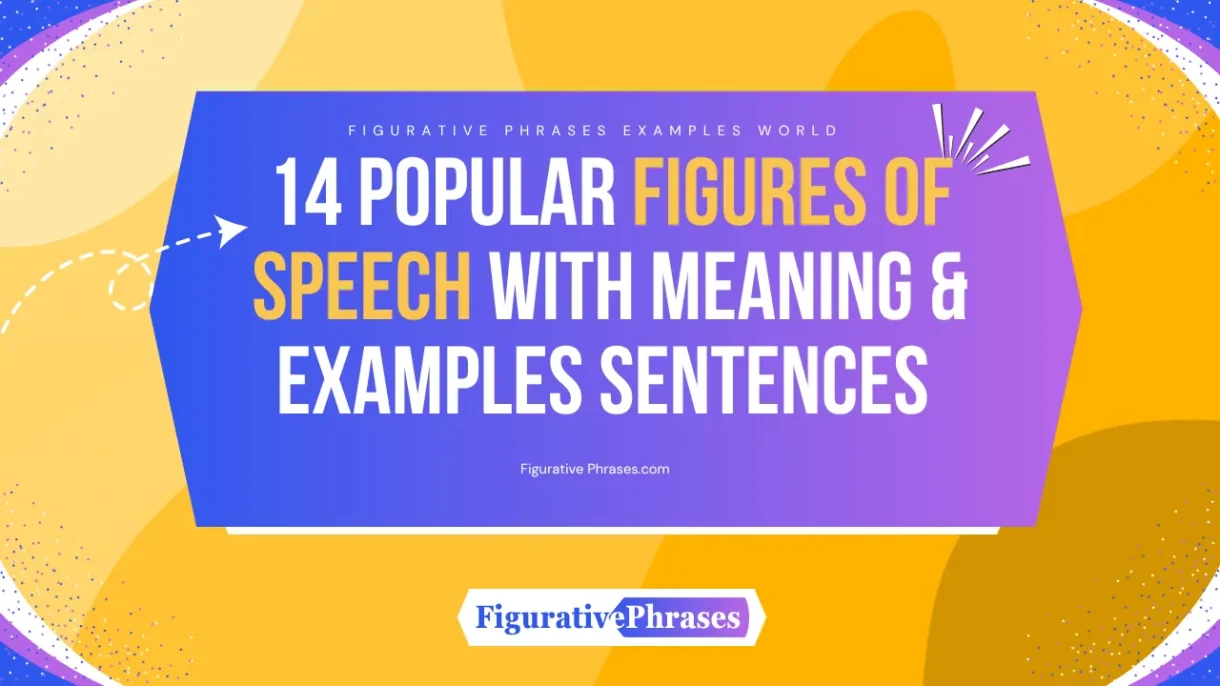
Figures of speech is use of imaginative words to express beyond the literral meaning. Most popular figures of speech includes metaphors, simile, idiom, personification, Symbolism, allusion, hyperbole, litotes, irony, oxymoron, pun, alliteration, assonance and onomatopoeia. To use these figurative language devices effectivily you need to set first clear goal. Then find your relevent figure of speech, the figurative device that great and mostly fit in writing is metaphors or simile.
What is a figure of speech?
Figure Of Speech is figurative language device which uses non-literal words or phrase. it gives imaginative sense of the words beyond the literal meaning. Figures of speech fall into two divisions: schemes, which reshape normal word order, and tropes, which assign words meanings beyond their usual sense. Most common figure of speech are mostly used by writes.
What are the Common figures of speech??
Most Popular figures of speech that are meaning shifters (tropes) metaphor, simile, idiom, personification, Symbolism, allusion, hyperbole, litotes, irony, oxymoron, pun, and Sound shapers (schemes) alliteration, assonance, onomatopoeia. First i discuss metaphor.
What is Metaphor?
Metpahor is a direct comparison that says A is B to transfer qualities from B to A. It fuses ideas and compresses meaning.
Example: “All the world’s a stage.” — As You Like It 2.7 (Shakespeare).
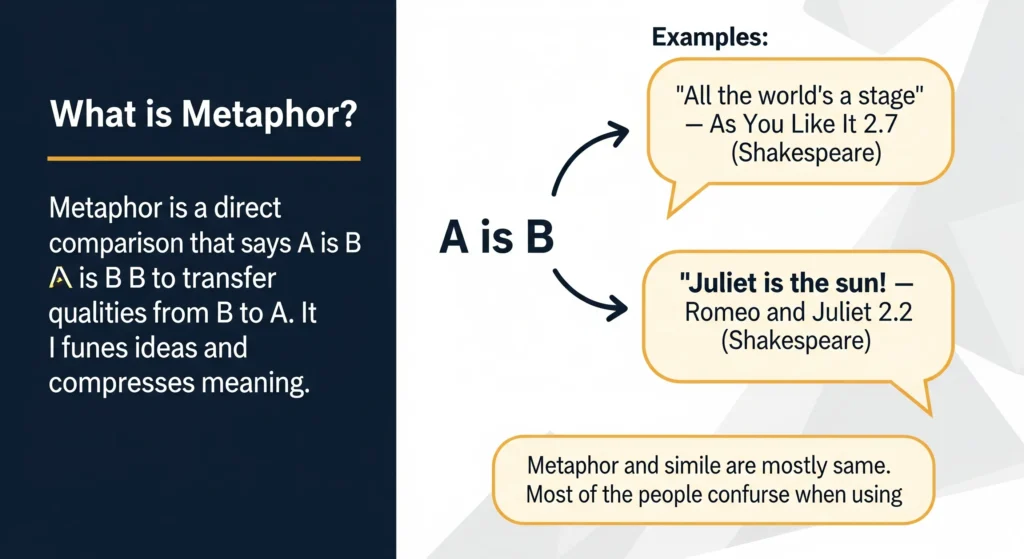
“Juliet is the sun!” — Romeo and Juliet 2.2 (Shakespeare).
Metaphor and simile are mostly same. Most of the people confuse when using.
What is Simile?
Simile is indirect comparison that uses “like” or “as”. It keeps two things distinct yet linked.
Example: “Like a patient etherized upon a table.” — T. S. Eliot, “Prufrock.”
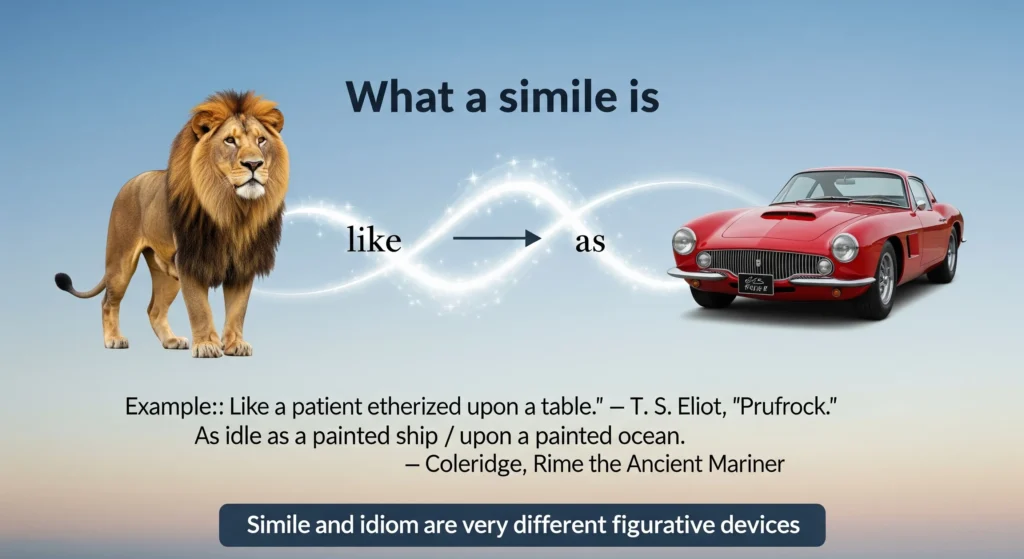
“As idle as a painted ship / upon a painted ocean.” — Coleridge, Rime of the Ancient Mariner.
Simile and idiom are very different figurative devices.
What is Idiom?
An idiom is a fixed expression whose meaning differs from its literal words.
Example: “Break the ice.” — The Taming of the Shrew 1.2 (Shakespeare).
“A wild-goose chase.” — Romeo and Juliet 2.4 (Shakespeare).
Idiom is a fixed phrase with a special meaning while personification gives things human traits.
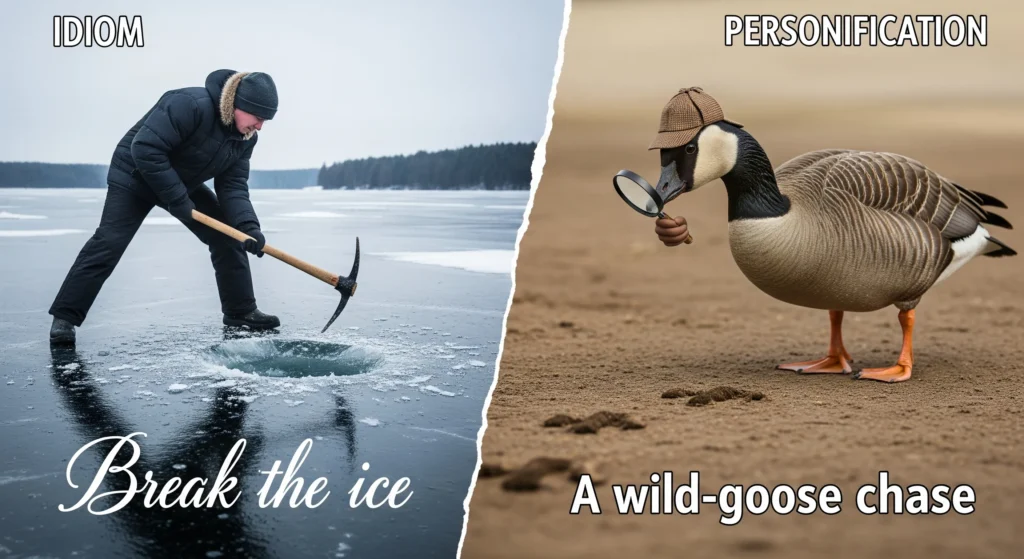
What is Personification?
Personification assigns human actions or feelings to nonhuman things. The object acts, feels, or speaks.
Example: “Because I could not stop for Death— / He kindly stopped for me—.” — Emily Dickinson.
“Death be not proud.” — John Donne, Holy Sonnet X.
Personification makes things act human; symbolism makes a thing point to an idea.
What is Symbolism?
Symbolism uses an object or image to represent an abstract idea.
Example: “And the Raven, never flitting, still is sitting…” — Poe, “The Raven.”
“The White Whale.” — Melville, Moby-Dick.
Symbolism makes an object carry an idea; allusion winks at a known story or figure.
What is Allusion?
An allusion briefly references a known text, event, or figure to borrow meaning.
Example: “So Eden sank to grief.” — Robert Frost, “Nothing Gold Can Stay” (Genesis).
“This was Icarus drowning.” — W. C. Williams, “Landscape with the Fall of Icarus” (Greek myth).
Allusion gives a quiet nod to something known; hyperbole shouts an over-the-top claim.
What is Hyperbole?
Hyperbole is purposeful overstatement for emphasis.
Example: “Ten thousand saw I at a glance.” — Wordsworth.
“Till China and Africa meet.” — W. H. Auden.
Hyperbole overstates on purpose but you know? litotes = understatement using a negative (e.g., “not bad”).
What is Litotes?
Litotes states an idea by negating its opposite, creating cool understatement.
Example: “Nor was his name unheard.” — Milton, Paradise Lost (Book 1).
“Not untrue and not unkind.” — Philip Larkin, “Talking in Bed.”
Litotes uses a negative to understate; irony says the opposite to reveal the truth.
What is Irony?
Irony presents a contrast between appearance and reality or expectation and outcome.
Example: “A young healthy child… is… a most delicious nourishing and wholesome food.” — Swift, A Modest Proposal. (verbal irony)
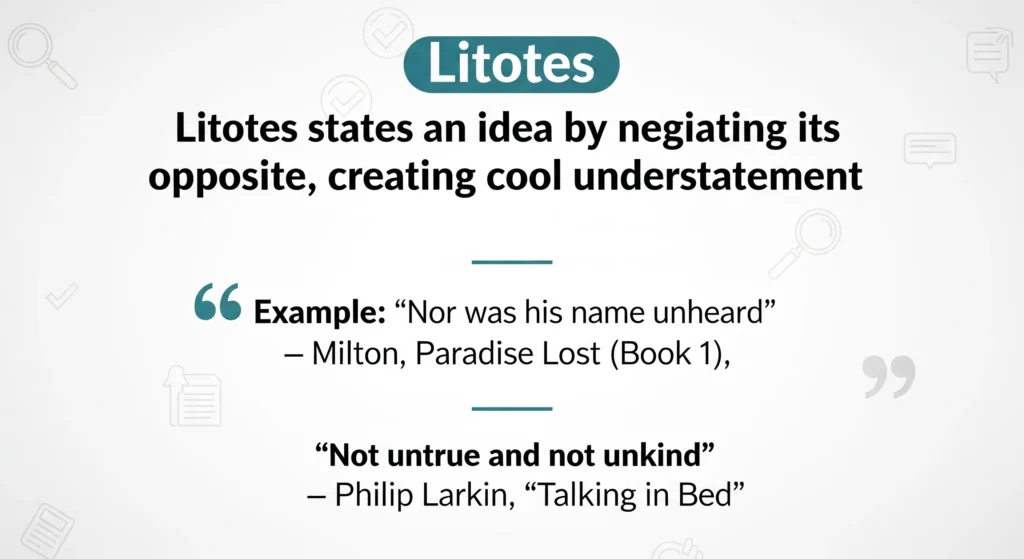
“I’ll… bring this to light myself!” — Sophocles, Oedipus Rex (dramatic irony).
“Water, water, everywhere, / Nor any drop to drink.” — Coleridge, Rime of the Ancient Mariner (situational irony).
Irony says one thing but means another; oxymoron places two opposite words together.
What is Oxymoron?
An oxymoron puts opposite words together to make a clever point.
Example: “Parting is such sweet sorrow.” — Romeo and Juliet 2.2 (Shakespeare).
“O brawling love! O loving hate!” — Romeo and Juliet 1.1.
Oxymoron pairs two opposite words; a pun makes a joke from double meanings or similar sounds.
What is Pun?
Pun is a wordplay that centers on similar sounds for humor or wordplay or multiple meanings.
Example: “Ask for me tomorrow, and you shall find me a grave man.” — Romeo and Juliet 3.1.
“A mender of bad soles.” — Julius Caesar 1.1.
Pun uses double meanings for humor; alliteration repeats the first sound of nearby words.
What is Alliteration?
Alliteration repeats initial consonant sounds to add rhythm or focus.
Example: “Full fathom five thy father lies.” — The Tempest 1.2 (Shakespeare).
“The fair breeze blew, the white foam flew.” — Coleridge, Rime of the Ancient Mariner.
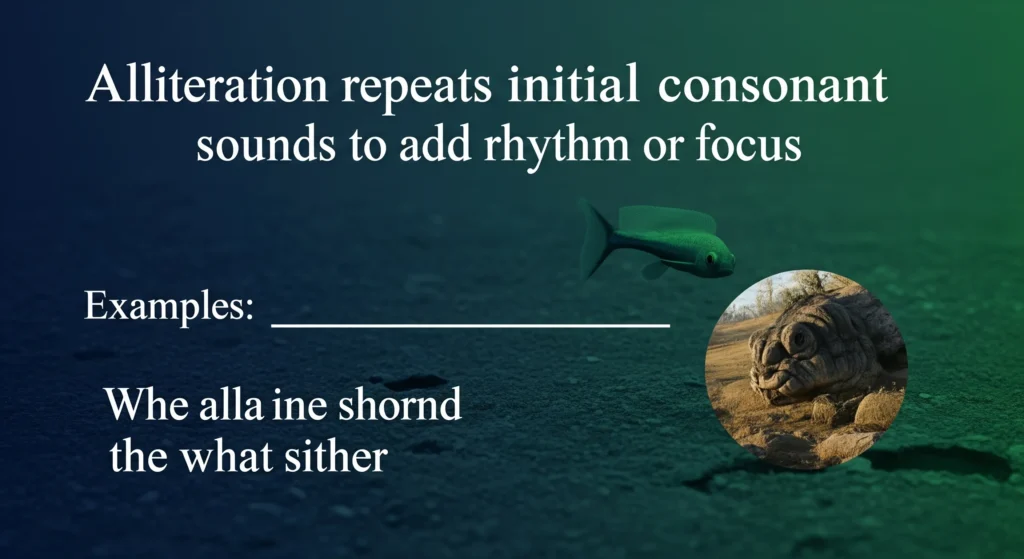
Alliteration repeats the first sound of nearby words; assonance repeats the vowel sound inside them.
What is Assonance?
Assonance repeats vowel sounds in nearby words to create internal echo and musicality. It supports mood and flow without full rhyme.
Example: “Hear the mellow wedding bells.” — Poe, “The Bells.”
“I hear lake water lapping with low sounds by the shore.” — Yeats, “The Lake Isle of Innisfree.”
Assonance repeats vowel sounds in nearby words; onomatopoeia uses sound-words such as “buzz” or “clang.
What is Onomatopoeia?
Onomatopoeia uses sound-imitating words to echo the action.
Example: “Tinkle, tinkle, tinkle.” — Poe, “The Bells.”
“I heard a Fly buzz—when I died—.” — Emily Dickinson.
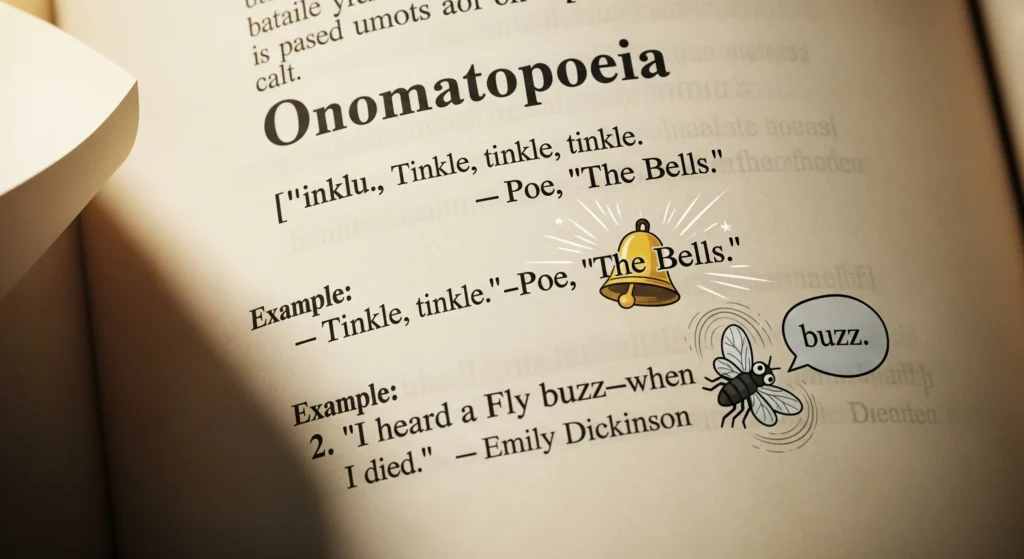
Onomatopoeia is last, After knowing popular figures of speech, how to write them?
How I use figures of speech in writing?
To use figures of speech in writing set a clear aim, choose one fitting device (metaphor, simile, personification, hyperbole, litotes, irony, pun, alliteration, assonance, onomatopoeia, oxymoron, allusion, symbolism), place it next to the key idea, anchor it with a plain clause, read aloud, and trim.
A writer first decides the purpose of the line, then picks a single device that serves that purpose. The literal idea stays on the page for clarity, while the device adds image, sound, or wit. Placement matters: the figure sits beside the main noun or verb. Sound devices shape pace; meaning devices carry sense. Freshness beats cliché. A short read-aloud and a quick cut keep the prose tight.
Steps:
- Read aloud and cut. Remove clutter, keep one device per sentence, and retain strong verbs.
- State the aim. Inform, persuade, or entertain—one choice rules the line.
- Select one device. Match goal to tool (e.g., metaphor to explain fast; litotes to soften; pun for wit).
- Write the plain clause. Put the literal point on the page first.
- Place the figure near the keyword. Keep image and idea side by side.
- Tune the sound. Use alliteration, assonance, or onomatopoeia to guide rhythm.
- Test for freshness. Swap in a dull image; if meaning drops, the figure earns its spot.
How Many Total Figures of Speech?
There is no fixed total Figures of Speech. Classical and modern handlists catalog 150–250+ named figures, while everyday instruction focuses on ~20–40 high-frequency forms that cover most usage.
What are the good figures Of Speech?
“Good” depends on the goal—clarity, emphasis, or music.
- Metaphor: strongest for concept transfer.
- Simile: safest for quick clarity.
- Personification: animates abstractions.
- Alliteration & Assonance: add sonic grip.
- Hyperbole: heightens emphasis.
- Irony & Litotes: control tone with distance.
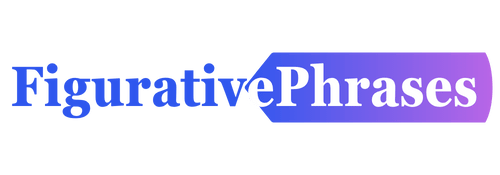





0 Comments